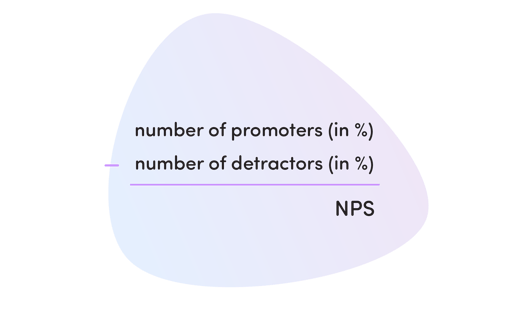Happy customers recommend your brand to the people around them. Those recommendations directly influence your growth rates (earned growth) in a positive way. On the other hand, unhappy customers have a direct negative influence on your growth.
The godfather of the Net Promoter Score, Fred Reichheld, developed the metric to easily measure customer loyalty and anticipate a company's growth. Considering the strong correlation between loyal customers and customers who recommend you, NPS is also a reliable metric for customer loyalty.
Reichheld observed that even though many companies collected customer feedback, they didn’t use its full potential and they were missing out on insights. The response rates for long surveys were usually very low, making the insights statistically irrelevant. Short surveys were an excellent solution. Reichheld’s team tested numerous questions to get an accurate depiction of customer loyalty, but one really caught the eye:
“On a scale from 0 to 10, how likely are you to recommend us to your friends or family?”
NPS also shows the overall perception of customers about a company and is therefore a useful metric for relational surveys. In practice, the Net Promoter Score is often used for transactional surveys, even though the Customer Satisfaction Score (CSAT) or the Customer Effort Score (CES) are better options if you want to ask your customer about a specific interaction. For example, how easy it was to return a package (CES)?
To get relevant insights it’s crucial to ask the right questions at the right moment. Considering NPS asks a more general question - “how likely are you to recommend us?” - it’s a good metric to use later in the customer journey. For example, with people who have been a customer for a while and when you want to understand how satisfied they are in general.
Based on their score, you can sort respondents into three categories:
The results of your surveys allow you to calculate your score. By deducting the number of detractors (in %) from the number of promoters (in %), you end up with a score between -100 and 100.

For example, a company can get the following results from their surveys:
This makes their Net Promoter Score 48. Is this a good NPS? Bain & Company makes the following suggestion: above 0 is good, above 20 is better, above 50 is great, and above 80 is a world-class NPS. However, the evolution of your score is more important than the score itself.
“A good NPS is a better score than yesterday’s!”
This idea shows exactly why NPS is so useful to measure how your company is improving and gauge overall customer satisfaction. If you measure your NPS regularly, you’ll clearly see if you’re doing well or if you still have work to do.
NPS surveys serve as a good alternative for long surveys. It’s important to keep them as short as possible and if possible limit yourself to two questions max. Our CEO Leslie Cottenjé emphasizes the importance of neutral questioning, as she’s described in her recommendations for NPS questions. Wrong or suggestive questions you tend to make your customers reflect on things they didn’t necessarily have an opinion on before starting the survey. But which questions should you ask?
The most used and best-known is this one:

However, you can research more than just the recommendation. Here are a few examples:
Along with customers, you can also use NPS to survey your employees (eNPS or the Employee Net Promoter Score). eNPS can give you valuable insights. It allows you to understand if your employees enjoy working at your company and if they have a good experience working at your company. In addition to this, it helps you understand if your employees have all the tools they need to assist customers. For situations like this, you could ask: “how likely are you to recommend our company as a potential workplace to friends or family?”
You use the Net Promoter Score to measure a customer’s willingness to recommend your company to a friend or colleague. This willingness is a strong indicator of customer loyalty, which stimulates retention, revenue growth, and revenue.
But the score alone isn’t enough. NPS is a powerful metric when you combine it with open feedback. It’s important to know why customers give you a certain score because the reason allows you to improve the customer experience.
A score can tell you if you’re on the right path, but not what you can do to improve your customer experience. In the end, that’s what it’s all about!
NPS doesn’t necessarily show a complete and up-to-date view of the customer experience. NPS provides a ‘snapshot’ of your customer experience at the moment of questioning, but it can change quickly. A small change to your website, working with a different external partner, … Friction can appear quickly and it’s crucial to notice it as soon as possible.
That’s why it’s important to measure your customer experience throughout the customer journey at specific and important interactions with customers so you’re always keeping an eye on it. Metrics like CSAT and CES are much better equipped for such feedback loops.
The Net Promoter Score is by far the most popular survey metric and an absolute must for every voice of customer and customer experience program. But NPS alone doesn’t suffice.
By asking the right questions and using open feedback you can gather the most accurate insights to take action. Take your time to find a combination that works for your company: map your customer journey and identify the most important interactions with your customers.

Subscribe to the Hello Customer newsletter and receive the latest industry insights, interesting resources and other updates.